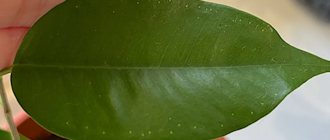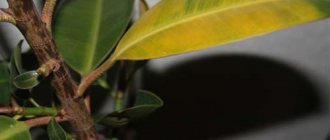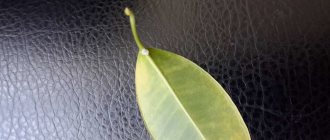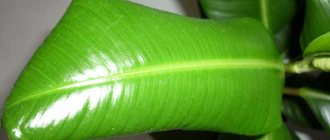Ficus benjamina are popular indoor plants, characterized by a high growth rate and expansion of leaf mass. Therefore, they are favorite objects for the formation of small indoor trees with a crown of various shapes.
Growing decorative ficus is not at all difficult. By regularly carrying out its formative pruning, you can get a beautiful tub plant and even a tree grown in the “bonsai” style.
In the article you will learn everything about forming the crown and trunk of Ficus Benjamin at home, as well as about pruning and pinching the plant.
Basic rules for pruning
Formative pruning of Ficus Benjamin is carried out in early spring, at the end of March or beginning of April. Before active growth begins, there is enough time for the cuttings to heal and for the plant to recover from the resulting stress.
To perform pruning, you will need garden pruning shears, charcoal or activated carbon, a clean cloth and a disinfectant (alcohol or potassium permanganate solution).
Before the procedure, you need to disinfect the pruning shears with alcohol or a solution of potassium permanganate to prevent any infection and the development of the disease.
Thick branches are cut at an angle as close to the bud as possible. Thin shoots are cut above the bud, shortening them by 1/3.
After pruning, wipe the cut areas of thick branches with a clean napkin to remove the milky sap that flows out. Then the sections are covered with crushed charcoal or activated carbon.
Sections of thin shoots do not need to be processed, but it is better to remove the sap that flows out, as it may leave white spots on the leaves of the plant.
In addition to shaping, there is also sanitary and rejuvenating pruning of ficus Benjamin. Let's look at how to shape a ficus benjamina.
What does a novice gardener need to know?
Before you grab your scissors and cut off half of your tree's branches, here are some basic rules:
- You cannot cut shoots at any time convenient for you. It is necessary to focus on the most favorable period for the growth and development of new stepsons. The end of February - beginning of March is most suitable for this purpose.
- For work, use only sharp, sterile instruments. A utility knife, nail scissors or small pruning shears will do. The blade must be disinfected before use to avoid infecting the plant with pathogens.
- If the cut stem has a thickness of more than 2 mm, then the cut site should be sprinkled with activated carbon powder or garden varnish so as not to deplete the ficus Benjamin, the formation of the crown of which will require a lot of effort from it to restore.
- The cut areas of small branches will heal on their own. The milky juice that appears must be wiped off.
- The shoots are cut off almost at the base, trying not to leave stumps on the main trunk. They not only look unsightly, but also contribute to the proliferation of fungal spores. Small stems on the side branches are cut directly above the bud at a right angle.
Sanitary pruning
Sanitary pruning of the plant can be carried out not only in the spring, but also at any other time of the year if necessary. It consists of removing dry, diseased and poorly developed shoots.
Dry branches must be removed as they look unsightly . They are also removed for safety reasons: sometimes dry branches become sources of various fungal infections.
If any ficus disease occurs, the affected areas of the shoots are cut off and burned. To do this, you should not wait for spring; such pruning is carried out as soon as possible.
Poorly developed shoots are removed because they are not very decorative. They also increase the density of the crown, preventing light from entering it.
Leaves turn yellow and fall off
Sometimes suddenly Ficus benjamina drops its leaves, which first turn yellow. The most common reason for plant defoliation is a decrease in the amount of light that individual leaves do not receive. They are in the shade. They are blocked from the light by other foliage. What to do about this and what actions to take, you ask?
Rotate the pot 90° throughout the day. This technique helps the plant feel good and not shed its leaves. In winter, additional lighting with a fluorescent lamp will not hurt.
Ficus Benjamin's leaves turn yellow and fall off for other reasons as well. For example, gradual cooling over a period of days or weeks usually does not present any particular problem, but exposure to sudden drafts or cold causes the symptoms we are talking about now.
See also: Complete amaryllis care at home
So, keep your ficus away from open windows and doors, including air conditioners and heaters. In winter, use a humidifier.
Improper watering is another common reason why leaves fall. Watering should be done as needed, and not on a schedule when the top layer of soil becomes dry, but not overdried. Good drainage will help protect the plant from root rot, which also causes leaves to turn yellow and fall off.
Finally, the last two reasons for yellowing and falling leaves are pests and fungus. Fungicides are used to treat the fungus, and pests are eliminated using insecticide preparations.
Anti-aging pruning
This type of pruning is carried out to restore the decorative appearance of very old ficus plants or plants whose shoots have lost their viability for one reason or another.
Sometimes, when the soil dries out strongly and for a long time, almost all the branches of the tree dry out . In this case, the ficus should not be thrown away; you need to carry out anti-aging pruning.
This procedure is carried out in early spring before the growing season begins. All dead branches are cut out, and living ones are shortened by half. Moreover, not only the main shoots are cut off, but also shoots of the second order. All sections are carefully sprinkled with activated carbon.
When the crown is completely dry, Ficus Benjamin can be trimmed “to a stump” by removing all branches and trimming the trunk. The remaining stump should be no higher than 7-10 cm. Gradually, the plant will restore the crown, growing new young shoots.
Types of crowns and their formation
Before you think about how to form a crown, you need to decide on its type.
Today the most popular are:
- Bush.
- Standard.
- Tiered standard.
- Bonsai.
- Sculpture.
Some people believe that it is quite difficult to shape a plant; to do this you need to be a florist or designer. In fact, everyone can not only learn how to form the crown of a Ficus Benjamin, but also do it themselves, following simple steps.
Bush
To form a bush, both low-growing and tall ficuses are used. Small-leaved varieties are very popular: they make the bush more lush. To quickly form a bush crown, 2-3 cuttings are simultaneously planted in a pot close to each other.
After planting, as soon as the rooted cutting 15 cm high begins to grow, it is pinched from above, leaving at least 5 leaves.
This stimulates the growth of 4-5 side shoots. When the side shoots reach a length of 10-15 cm, their tops are also cut off .
In this case, the remaining upper buds should be directed not inside the crown, but outward. All sections should be wiped with a napkin to remove white juice and sprinkled with activated carbon.
After the second pruning, when the shoots of the third level reach a length of 10-15 cm, a fairly dense bush is obtained. If the bush is very dense, you can cut 2-3 branches from the middle of the bush and thin it out.
When growing a bush crown, you need to illuminate the plant evenly or periodically turn it to the light in different directions so that the shoots grow evenly.
Features of care after pruning
When the ficus is pruned, it should be given proper care.
To do this, follow these recommendations:
- after pruning, there are fewer branches, which means that watering should be reduced, since the plant’s need for water decreases;
- bonsai requires daily moisture, due to the rapid drying of the soil in small containers;
- In order for young shoots to begin to appear and grow more actively, any growth regulator should be used, for example, the drug “Epin”;
- As the ficus grows, the shoots must be pinched to maintain the shape of the crown;
- Rearranging the ficus should be avoided, as it does not like to be moved.
Such care will help consolidate the result after the crown is formed.
Important! The flower pot should be protected from direct rays of the sun, as they can cause burns on young shoots.
Stamb
Standard crowns are forms with a pronounced trunk. To grow a trunk, a single cutting is planted. During its growth, all the resulting lower side shoots are removed, leaving 3-4 upper ones.
If you want to grow a standard tree 50 cm high, then the length of the lower part of the trunk without branches should be 15-20 cm.
Typically, desktop specimens have a height of up to 50 cm, and floor-standing ones are much higher: 90-100 cm.
After the lower part of the trunk is formed, they begin to build up the crown. When the plant reaches the desired height, the top shoot is cut off by 5-10 cm.
After this, the side shoots begin to grow intensively. They should be left only within the crown. If they form in the lower part of the plant on the trunk, they must be removed.
Next, the crown is formed in the same way as a bush. When pruning, the outer buds should be directed outward. Don't forget to treat the cuts with activated carbon.
The standard ficus crown can be given various shapes . The spherical crown is very popular and beautiful, but the oval shape, extended upward or to the sides, is no less decorative. When creating a crown in the shape of a ball, you need to leave shoots of the same length when pruning.
Is it possible to prune the plant?
We recommend that you read
Gardeners are debating whether it is possible to prune a ficus at home, and how to shape it so that the plant has normal growth. Many flower lovers successfully prune at home if there is a desire to give it some shape or if this is necessary for sanitary reasons.
For each type of pruning (lush small bush, branched crown) there is a certain rule. Before you start pruning, you need to decide what the expected result will be. Not every variety of ficus (with a single shoot trimmed) will continue to grow well.
A rubber ficus that has been pruned can continue to grow with only one shoot. You can prune a plant that has short internodal distances. It is necessary to make a horizontal cut above the bud for an oblique shoot that has a thin or still green appearance. Whatever type of ficus is pruned, there is no need to leave large stumps. They can be sources of plant infection with fungal diseases.
Sanitary pruning of ficus is carried out at any time. This must be done in order to prevent poorly developed, broken and dried shoots from infecting the entire ficus.
A rejuvenating type of pruning is usually performed when a flower has dried shoots that have appeared as a result of a long lack of watering and drying out of the soil (this is especially true for dwarf plant species). When the trunk freezes in the upper part, you need to trim it “under the stump”. The ficus root shoots will quickly be able to resume their growth. After some time, you will need to take a stem to grow the plant in a standard or bush form. The main thing is that he has at least a few escapes. You can create a lush crown if the shoots are properly shortened or pinched.
Tiered standard
Tiered trunk is a form of tree with a crown divided into parts. Between its tiers there remains a bare trunk without branches. Such a tree can have 2 or more tiers.
Sometimes tiers are built up gradually . First, a regular standard tree with a round or oval crown is formed. Then pruning is carried out in such a way that the central shoot grows upward.
Gradually, it will be possible to form a continuation of the trunk, and then a new tier of the crown. This is the longest process of forming a longline trunk.
It is much faster to plant 2 cuttings at once and fasten their trunks with wire. Gradually, below they will grow together into a single trunk. The plants will be separated at the top.
Each of them can be grown as a regular standard, but their crowns will be at different heights. If you plant cuttings with different leaf colors, you can get a very beautiful tree with different colors of the crown tiers.
A tiered trunk can be grown from one cutting . It should grow upward, forming an elongated tall single trunk. After the formation of the lower part of the trunk, its crown must be divided into 3 parts.
The lower and upper parts will be two tiers of the trunk, the central part will be the bare trunk located between them. In the center, all side shoots are removed and the top of the tree is pinched. The tiers are formed like a regular single trunk.
Bonsai
Almost all varieties of ficus benjamina can be used for growing bonsai. But the Viandi variety is most suitable for this purpose. It is characterized by a low growth rate and a wavy, curved trunk. From cuttings of this variety you can grow a bonsai the fastest.
The technology for growing these dwarf trees for Ficus Benjamin and for other species is practically the same. Bonsai are grown in low, wide containers filled with depleted soil, which promotes a slow growth rate. The roots of the tree are pruned 2-3 times a year, after which it is planted in the same container. The plant is also pruned 2-3 times a year.
In addition to pruning, great importance is attached to the formation of the trunk and branches.
The branches and trunk are wrapped with thick copper wire, and then gradually bent so that the plant takes on the desired shape . Usually after such procedures, after 4-5 years the plant looks like a real tree in miniature.
Why and when can you prune ficus benjamina?
Pruning for Ficus Benjamin can be sanitary, rejuvenating and formative. The first two have a positive effect on the condition of the plant itself, and the latter makes it highly decorative.
Important! It is extremely undesirable to carry out pruning operations (except for sanitary ones) in the autumn-winter period. This weakens the ficus, and it may begin to develop one-sidedly.
The optimal time for pruning is the beginning of spring, when the dormant period ends and the plant begins to actively develop.
Sculpture
It is very difficult to grow a crown in the form of a sculpture; work on it takes a long time.
Only an experienced gardener can create a tree in the shape of an animal or bird. It is easier to make the crown in the form of a geometric figure - a cone or cylinder. Even the formation of a simple geometric crown takes several years.
In this case, it is necessary to prune the plant annually in the spring, cutting off the branches so that the crown takes on the desired shape.
Usually the branches directed outward are left, and the crowns growing deeper are cut out.
At the same time, the outer part of the crown branches out greatly, so it becomes easier to give it the desired shape.











